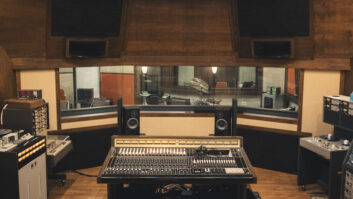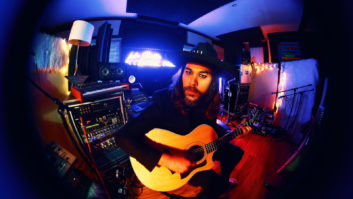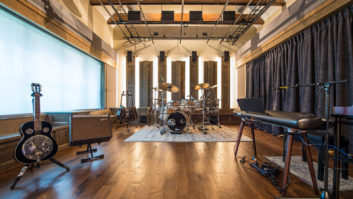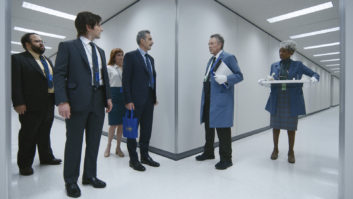On his Continuing Adventures In Software, Rich Tozzoli follows the Abbey Road.
Waves’ EMI TG12345 Plug‐In The Waves EMI TG12345 Plug-In was developed with Abbey Road Studios and was meticulously modeled on the actual console used by the Beatles for Abbey Road. This was the first solid-state console from EMI, and the plug-in is a complete TG12345 channel strip. Wow, was I looking forward to putting this thing to work!

With how the world actually operates now, I began by reading the ‘Behind Abbey Road Studios’ EMI TG12345 Consoles’ fact sheet and watching the cool EMI TG12345 in-depth tutorial on YouTube (scary but true). I found out a handful of interesting facts, like the console was originally commissioned in 1968, where it was used by the likes of the Beatles and on Pink Floyd’s Dark Side Of The Moon and Wish You Were Here. The plug-in itself covers all the options through each incarnation of the desk, MK 1 up to the MI IV. The video tutorial (which is over 41 minutes long!) then takes you through the entire signal path and individual sections of the plug-in.
The layout is quite straightforward, depending if you are running mono or stereo. The Input section is on the left, followed by the Dynamics. In the middle is the Routing, then the EQ. On the right is the Output section along with the meters. The Input features -24 dB to 24 dB of gain, and the Dynamics Mode allows you to choose between Out, Compressor (2:1) and Limiter (7:1). The Hold knob is interesting in that it sets a constant DC voltage for the sidechain that feeds the VCA, Recovery sets the release time (six options from 100 ms to 5 s), and SC-HP applies a high pass filter on the sidechain at around 90 Hz. Mix is a blend control between compressed and uncompressed.
Routing allows you to change the order of the signal flow, with EQ first, then Dynamics, then Presence; Dynamics first, then EQ, then Presence; or EQ first, then Presence, then Dynamics. EQ features a fixed bell Boost at 5 kHz, a Cut fixed at 10 kHz, and Presence—a bell filter controlling the center frequency of the presence filter, which has a range from 500 Hz to 10 kHz. The Presence knob boost or cuts the presence filter 10 dB. Bass is a low shelf filter fixed at 50 Hz and EQ Bypass bypasses the entire EQ section.
The (Stereo) Master section features Phase On/Off and a Channel Selector for Mono, Stereo or L/R (choose between the two different modeled channels), Drive, Noise, Spread which controls the balance between the mid and sides by changing only the sides, Monitor which selects the source of the monitor output from Left, Mono, Stereo and Right, and Output which features gain after processing (-48 dB to 24 dB). The VU Meter displays input, output or gain reduction levels and the Peak Meter displays signal peak output level.
I put it right to use on distorted electric guitars, on a Sennheiser MD 421 track. Turning first to the EQ, I set the Presence to 4.2 kHz and pushed up the Presence knob. Hello! I then turned the Treble up a bit and cut the Bass, and had me one nasty-ass guitar sound. Pushing it farther, I put the Comp in, and experimented with the Hold. As you push it up higher, its seems to “find” the compression, and thicken the overall sound a bit—while reducing the gain. I pushed up the fader a few dB, and set the Recovery to 4, which acted quick enough to make the compression actually work on the track. I then pulled the Mix back a bit to around 60 percent, and it was worthy of a preset save.
Experimenting further with the Routing, I found—for this sound— the EQ>Dyn>Pres to work best, giving the sound the most air while retaining the thickness. On further testing, it’s a case-by-case basis as to what works for each situation, but it’s a great sonic option to have.
Next, I put the plug-in on a kick drum, and went into the useful presets folder. I loaded Big Kick; it was just that—big, thick and nasty, but a bit overcompressed, which was easily rectified with the Mix knob. In the mix itself, which was quite dense, I was even more impressed. It had tick enough to punch it through, and thump enough to push the bass. The preset features compression with the Limiter and Dyn>EQ>Presence routing. The 10 kHz Treble was up to +6, but the 0.5 kHz Presence was cut -10 dB, with the Bass up at +6. It was a great place to start, and showed once again how presets can teach. On bass, I had to work harder to get a good sound, trying different combinations of Hold, Mix, Presence and Drive. I tried Drive on a variety of sources, and it’s a little crunchy for my taste, so I didn’t use it much. But hey, if this thing helped make that McCartney bass sound, what do I know?
I also tried it on the master bus, testing the Spread feature. You can actually hear it sound like it’s getting wider by pushing it up, but what it’s doing—to my ears—is pulling some of the thickness out between the sides and the middle. But what I really liked on the stereo mix was adding a tiny bit of 10 kHz Presence, which gave it the air I was looking for.
The Abbey Road TG12345 can give deliver a slice of the old school, but in a cool modern way. My personal favorite use was on guitars and it’s a piece I’ve already worked into my production routine.
Waves
waves.com







